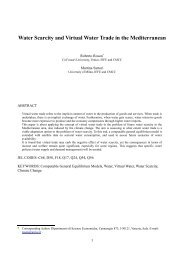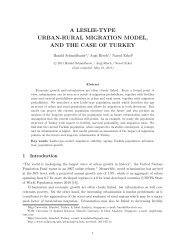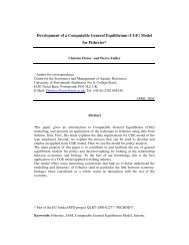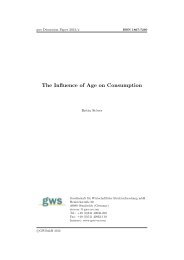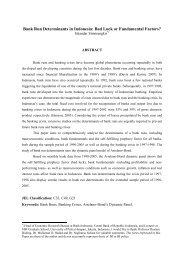Maturity Transformation and Interest Rate Risk in Large European ...
Maturity Transformation and Interest Rate Risk in Large European ...
Maturity Transformation and Interest Rate Risk in Large European ...
Create successful ePaper yourself
Turn your PDF publications into a flip-book with our unique Google optimized e-Paper software.
Table 7: Frequency of ≥ 2% <strong>in</strong>crease <strong>in</strong> the level of historical (forward or zero) yield curves over anl−month period for various values of l. Subtables (a) <strong>and</strong> (b) are computed by estimat<strong>in</strong>g Nelson-Siegel<strong>and</strong> Svensson parametric forms respectively at each month-end <strong>in</strong> the sample, <strong>and</strong> by then exam<strong>in</strong><strong>in</strong>gthe longitud<strong>in</strong>al distribution of β 0 . In each subtable, the first row shows the number of times wherean l−month change <strong>in</strong> β 0 meet or exceeds 2%, the middle row shows the number of longitud<strong>in</strong>alobservations on which this count is based, <strong>and</strong> the f<strong>in</strong>al row shows the frequency obta<strong>in</strong>ed by divid<strong>in</strong>gthe first row by the second.(a) Nelson-Siegel1 3 6 9 12 15 18 24number ≥ 2% 1 3 5 5 6 6 2 6number observations 166 164 161 158 155 152 149 143frequency (%) 0.60 1.83 3.11 3.16 3.87 3.95 1.34 4.20(b) Svensson1 3 6 9 12 15 18 24number ≥ 2% 4 6 14 19 22 29 36 33number observations 166 164 161 158 155 152 149 143frequency (%) 2.41 3.66 8.70 12.03 14.19 19.08 24.16 23.084.3 How representative is a 2% parallel yield curve shock?In Table 7 we show the frequency of large parallel shifts <strong>in</strong> the yield curve, under the Nelson-Siegel<strong>and</strong> Svensson models, over various time horizons. Under the Nelson-Siegel model, such large moves<strong>in</strong> the yield curve are rare even over 24 months, while under the Svensson model they are much morefrequent. The most relevant time horizons for our purposes are up to 3 months, <strong>in</strong> which time wemay expect a bank to be relatively unable to make major portfolio adjustments <strong>in</strong> response to sharpyield curve changes. Based on time horizons of up to 3 months, we might estimate that a 2% parallelupward shift <strong>in</strong> yield curve occurs with probability between 0.6% <strong>and</strong> 3.7% <strong>in</strong> any one month, whichcorresponds to someth<strong>in</strong>g between a 1 <strong>in</strong> 14 year event <strong>and</strong> a 1 <strong>in</strong> 2 year event. This gives an idea ofthe ‘severity’, or lack thereof, of a 2% shock to the level of the yield curve.In addition, we would like to <strong>in</strong>vestigate the extent to which it is reasonable to shock the level ofyield curves without also vary<strong>in</strong>g other shape parameters of the yield curve. In particular if slope <strong>and</strong>level changes tend to occur together, then the revaluation effect of a level shock only may under- oroverstate the revaluation effect of a shock to both levels <strong>and</strong> slope. We present an <strong>in</strong>itial <strong>in</strong>vestigationof these relationships between chang<strong>in</strong>g parameters <strong>in</strong> Table 8, where the subtables correspond todifferent time horizons over which we might measure the change <strong>in</strong> parameters. The correlations arestable between tables. They show that changes <strong>in</strong> the level <strong>and</strong> slope of the yield curve, as parametrisedby β 0 <strong>and</strong> −β 1 , exhibit a strong positive contemporaneous correlation over 1, 3, 6, 9 <strong>and</strong> 12 months. 32Increases <strong>in</strong> the level of the Euro yield curve are associated with simultaneous <strong>in</strong>creases <strong>in</strong> the slopeof the yield curve over all of these time horizons, <strong>and</strong> the absolute size of the correlation decreaseswith the time horizon. Similary, level <strong>and</strong> curvature show a strong negative association, suggest<strong>in</strong>gthat yield curves flatten when they shift upward, <strong>and</strong> the absolute size of this association <strong>in</strong>creaseswith the time horizon. We therefore note, that regardless of the severity of the <strong>in</strong>terest rate shock onewould like to apply (for example a 2% level change), association between level, slope <strong>and</strong> curvatureare highly prevalent historically. We regard these relationships as evidence aga<strong>in</strong>st the plausibility ofa parallel yield curve shock. These relationships should be used <strong>in</strong> a proper assessment of <strong>in</strong>terest raterisk.It is well known that correlation is not a very satisfactory measure of dependence. In a sense,correlation only captures a type of ‘l<strong>in</strong>ear’ dependence, which might ignore important <strong>and</strong> measurable‘non-l<strong>in</strong>ear’ relationships. As a robustness check on our correlation estimates, we provide scatterplotsof the levels <strong>and</strong> month-on-month (l = 1) changes <strong>in</strong> the β parameters of the Nelson-Siegel model <strong>in</strong>32 β 0 <strong>and</strong> β 1 are negatively associated, so that β 0 <strong>and</strong> −β 1 are positively associated, <strong>and</strong> hence <strong>in</strong>creases <strong>in</strong> level arepositively correlated with <strong>in</strong>creases <strong>in</strong> slope.25




